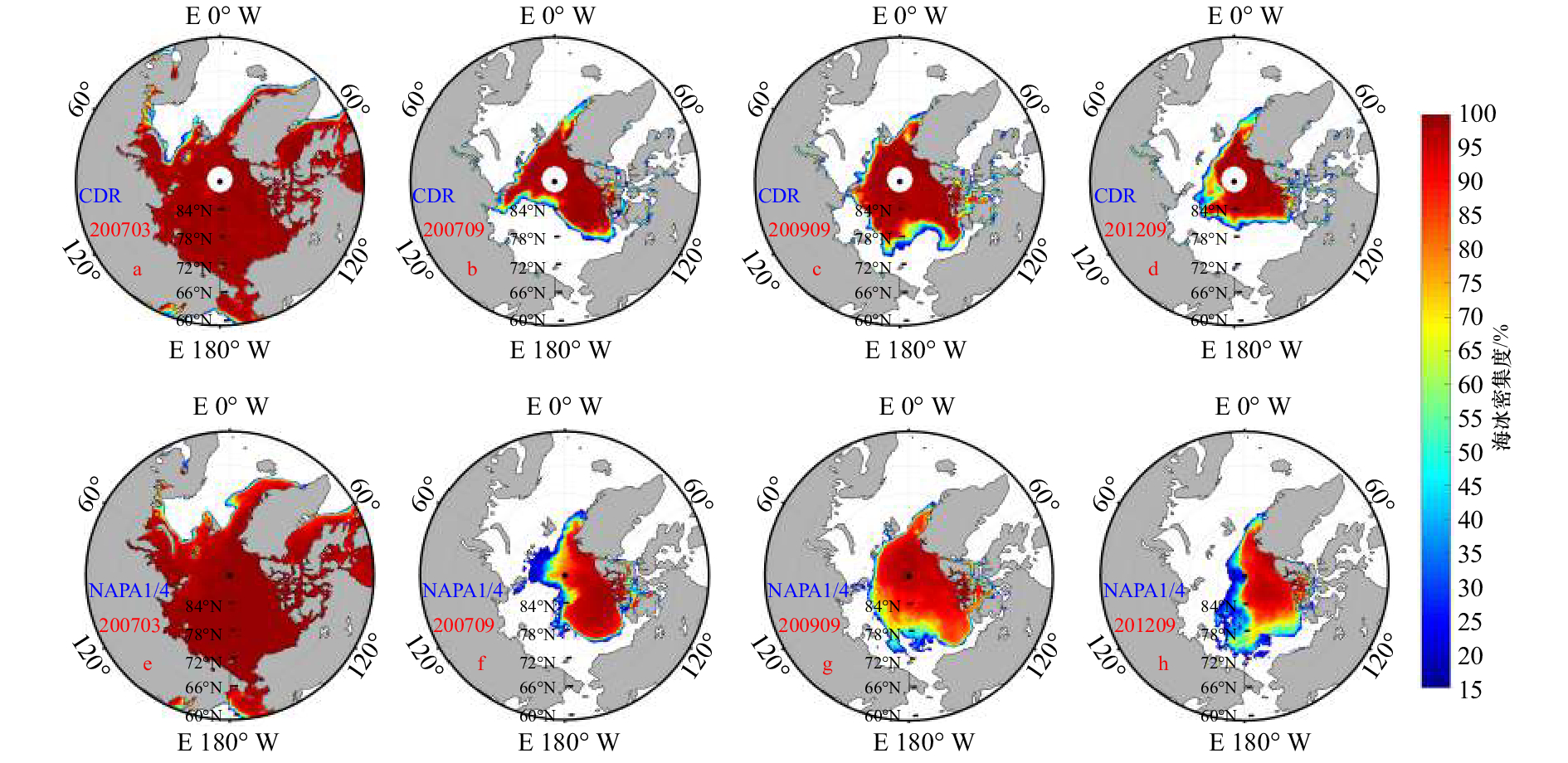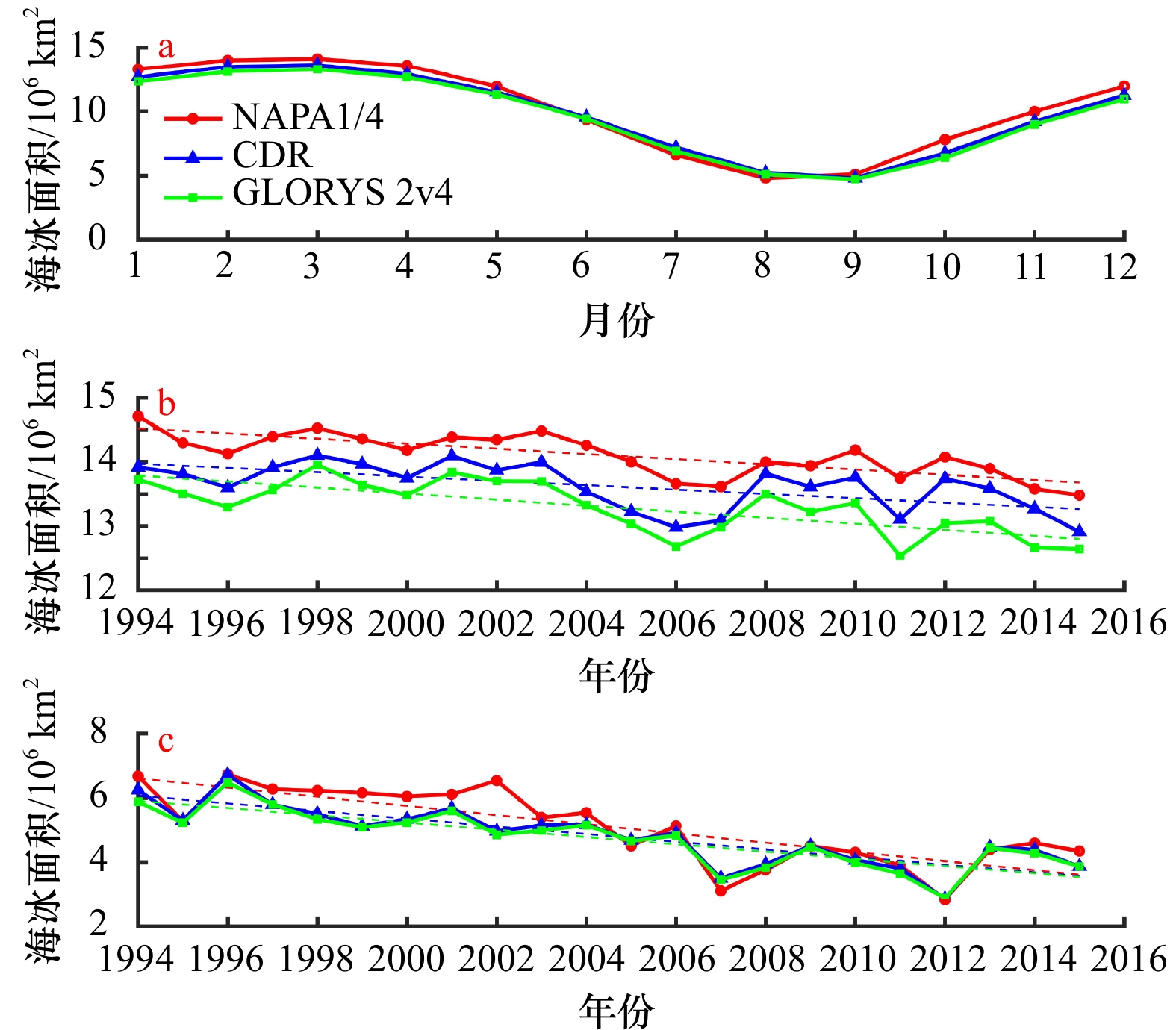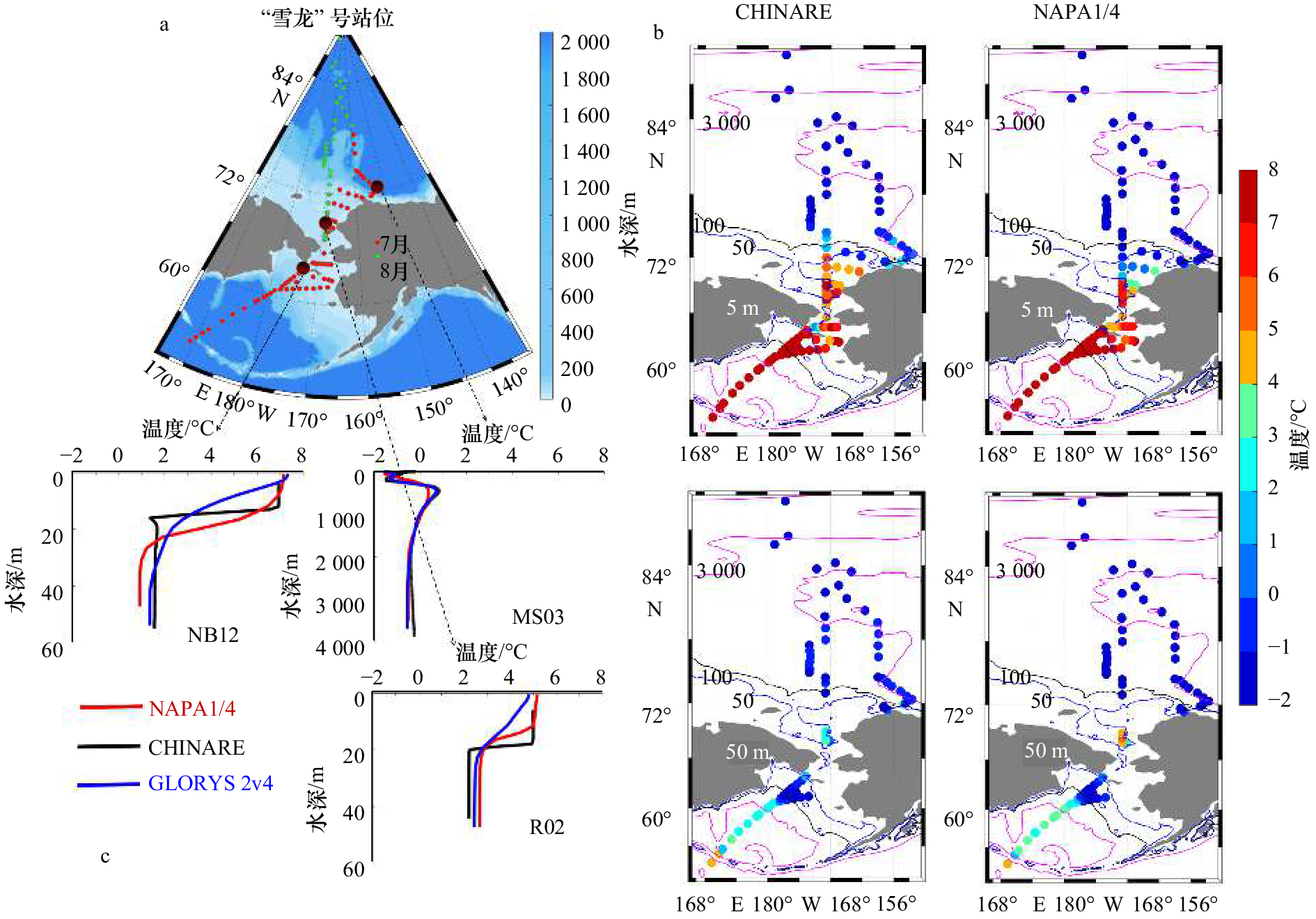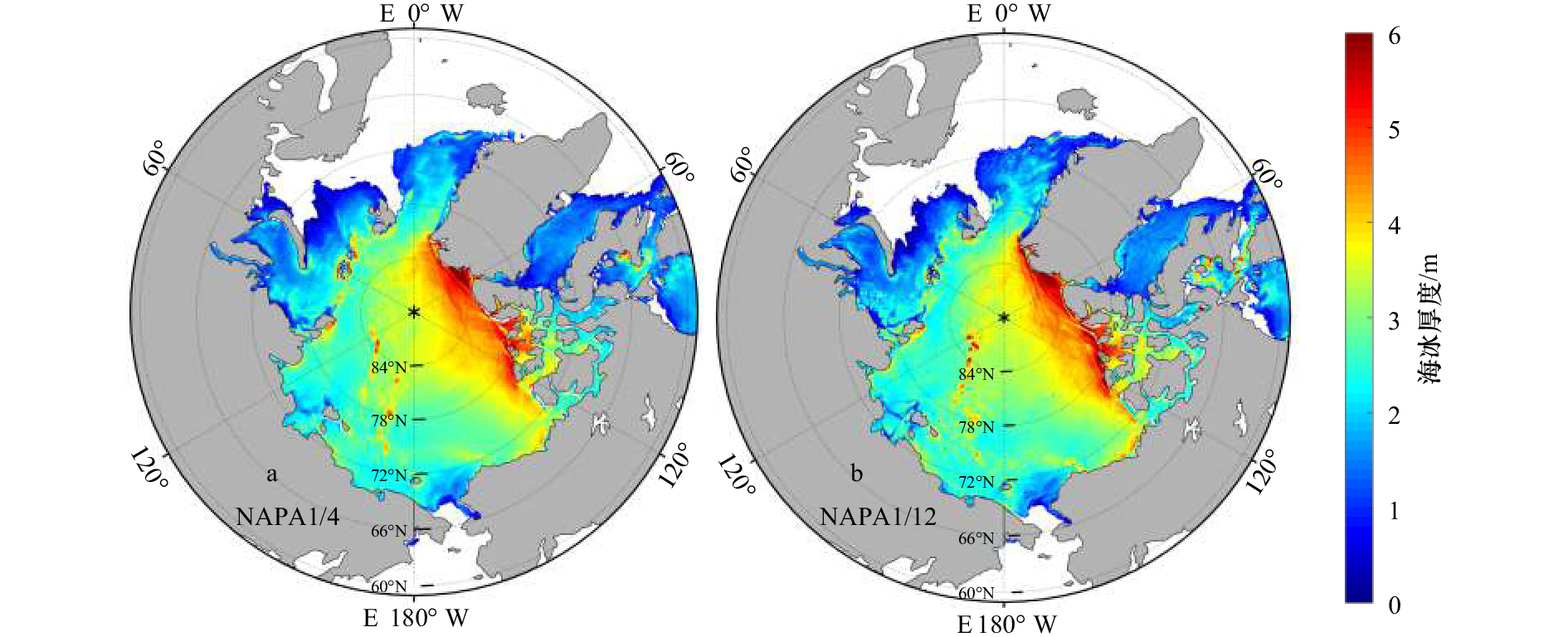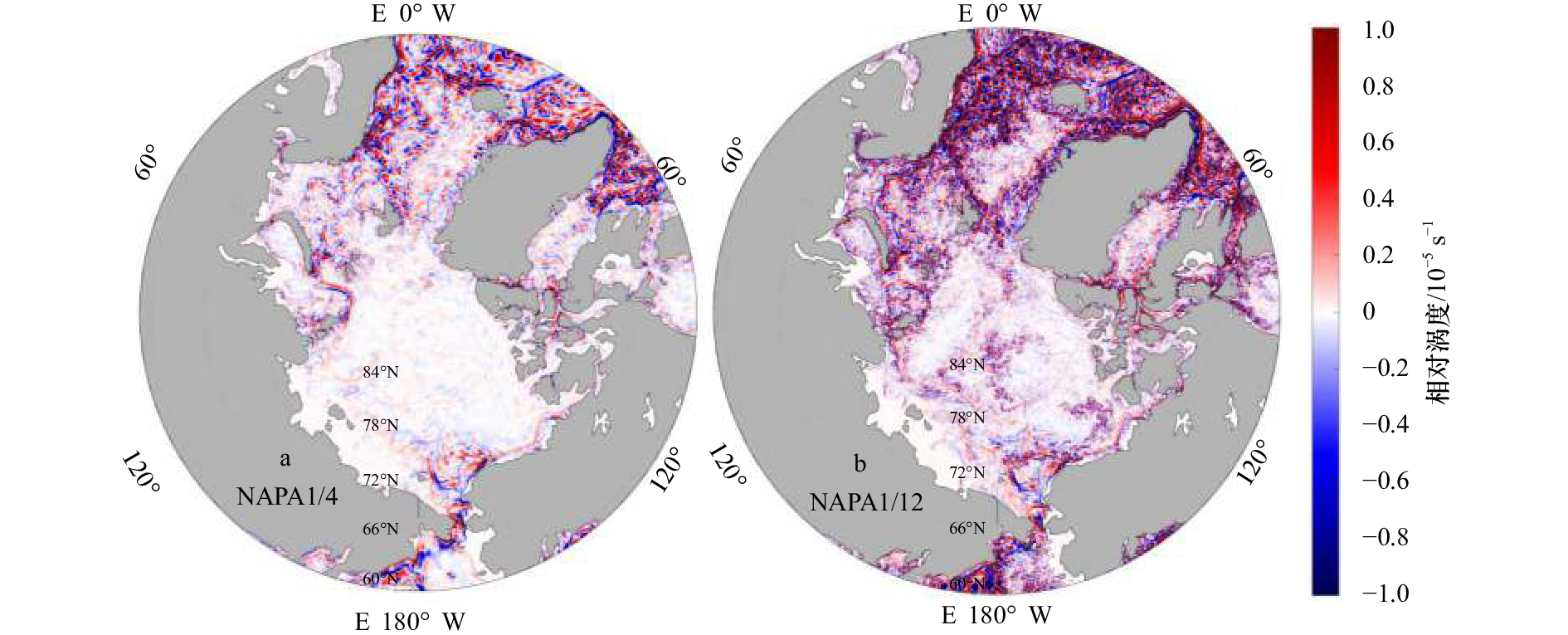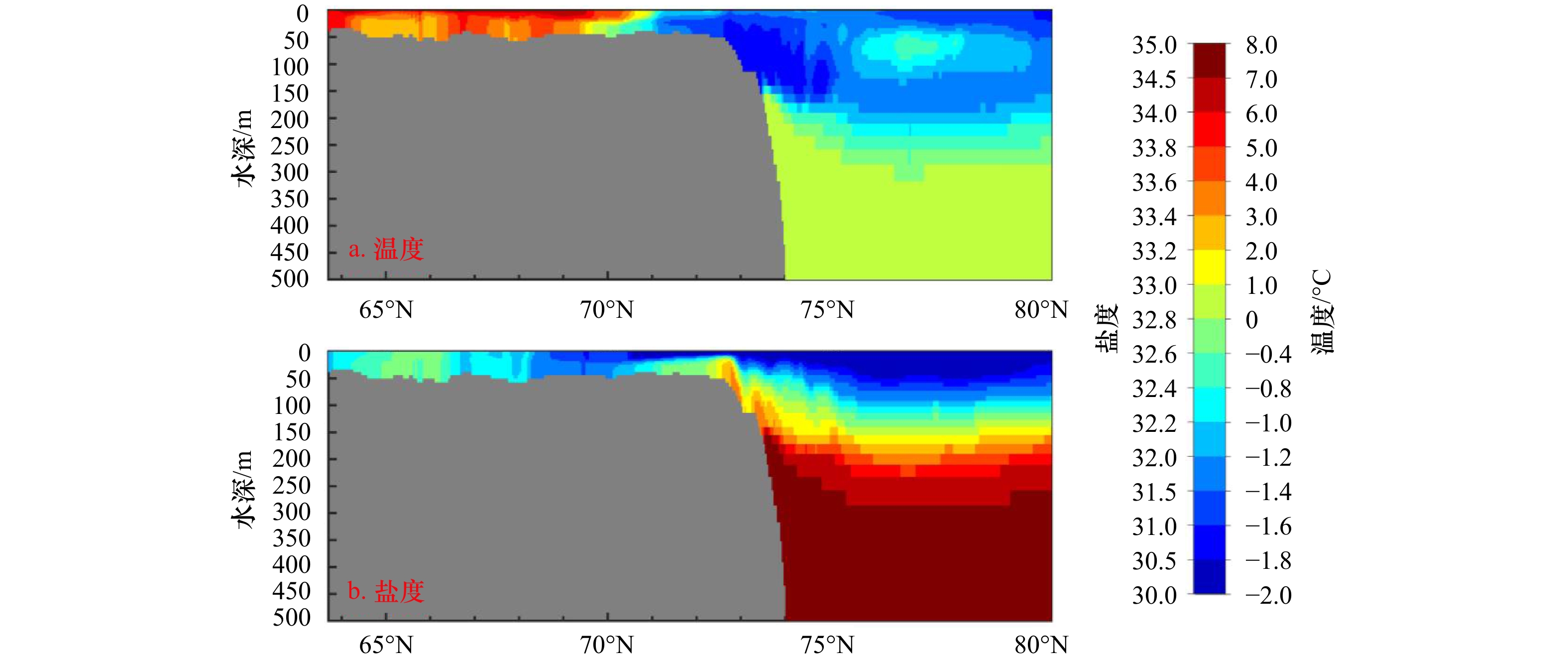Evaluation of hindcast simulation with the ocean and sea-ice model covering the Arctic and adjacent oceans
-
摘要: 本文将目前先进的大尺度海洋、海冰模式(NEMO3.6和LIM3)应用于北大西洋–北冰洋–北太平洋(简称NAPA),并进行了试验后报模拟。所建立的模式NAPA1/4和NAPA1/12的水平分辨率分别为(1/4)°和(1/12)°经、纬度,计算范围覆盖太平洋45°N以北海区、整个北冰洋及北大西洋;其中,NAPA1/4和NAPA1/12在北大西洋的边界分别为26°N和7°N。目前,已利用NAPA1/4完成了1993–2015年的后报模拟。本文基于观测数据和已发表文献对模拟结果中的北冰洋海冰变化、环流结构以及水文特征进行了校验。结果表明,NAPA1/4能够再现北冰洋的主要热力与动力过程,可以用来分析海冰、水团、大西洋/太平洋入/出流等的季节与年际变化规律。利用NAPA1/12进行了1993–1996年的模拟计算。初步结果分析表明,提高分辨率可更为精细地刻画北冰洋的海冰、水团和环流的结构。Abstract: Coupled ocean and sea-ice models, developed based on Version 3.6 of the Nucleus for European Modelling of the Ocean (NEMO), with the sea-ice component being Version 3 of Louvain-la-Neuve Sea Ice Model (LIM), are applied for hindcast simulations covering the North Atlantic-North Pacific-Arctic Oceans (NAPA). The two model configurations, NAPA1/4 and NAPA1/12, have nominal horizontal resolutions of (1/4)° and (1/12)° in latitude/longitude, respectively. The model domains cover the Pacific Ocean north of 45°N, the whole Arctic, and the North Atlantic north of 26°N for NAPA1/4 and 7°N for NAPA1/12. A decade-long hindcast from 1993 to 2015 using NAPA1/4 has been completed. The hindcast results of sea-ice, circulation and hydrography variations in the Arctic Ocean are evaluated with available observational data and previously published results. The evaluation suggests that NAPA1/4 possesses reasonable skills in reproducing the key thermal and dynamic processes, and can be applied to study the seasonal and inter-annual variations of sea-ice, water masses, and Atlantic/Pacific inflows/outflows. Preliminary analysis of the NAPA1/12 hindcast during 1993-1996 suggests that increasing horizontal resolution simulates more details of the spatial structures of sea-ice, water-mass properties, and ocean circulation.
-
Key words:
- coupled ocean and sea-ice models /
- model evaluation /
- Arctic Ocean
-
图 3 海冰面积时间序列
a.1994–2015年多年平均海冰面积逐月变化;b.3月海冰面积年际变化;c.9月海冰面积年际变化。红色圆点实线代表模拟结果;蓝色三角实线表示CDR观测数据;绿色方形实线表示GLORYS 2v4再分析数据;图中虚线表示对应颜色数据的线性拟合趋势
Fig. 3 Time series of sea-ice area
a.Annual cycle averaged over 1994–2015; b, c. interannual variation in March and September. The solid lines with red dots, blue triangles and green squares represent NAPA1/4 hindcast, CDR and GLORYS 2v4 reanalysis, respectively. The coloured dotted lines represent long-term trends obtained through linear fitting
图 4 白令海–楚科奇海–加拿大海盆水温分布
a. 第四次北极考察站位分布,红色为7月调查站位,绿色为8月调查站位;b. 观测与NAPA1/4模拟的5 m层和50 m层温度分布的比较;c. 白令 海、楚科奇海、加拿大海盆区3个站位观测、GLORYS 2v4再分析与NAPA1/4模拟的温度剖面
Fig. 4 Water temperature in the area covering Bering Sea, Chukchi Sea and Canada Basin
a. Locations of sampling stations from the fourth CHINARE-Arctic expedition with red and green dots denoting samples deployed in July and August, respectively; b. temperature distribution at depths of 5 m (upper) and 50 m (lower) from CHINARE (left) and NAPA1/4 (right); c. temperature profiles at 3 stations in Bering Sea, Chukchi Sea and Canada Basin based on CHINARE, GLORYS 2v4 and NAPA1/4
图 5 白令海–楚科奇海–加拿大海盆盐度分布
a. 第四次北极考察站位分布,红色为7月调查站位,绿色为8月调查站位;b. 观测与NAPA1/4模拟的5 m层和50 m层盐度分布的比较;c. 白令 海、楚科奇海、加拿大海盆区3个站位观测、GLORYS 2v4再分析与NAPA1/4模拟的盐度剖面
Fig. 5 Water salinity in the area covering Bering Sea, Chukchi Sea and Canada Basin
a. Locations of sampling stations from the fourth CHINARE-Arctic expedition with red and green dots denoting samples deployed in July and August, respectively; b. salinity distribution at depths of 5 m (upper) and 50 m (lower) from CHINARE (left) and NAPA1/4 (right); c. salinity profiles at 3 stations in Bering Sea, Chukchi Sea and Canada Basin based on CHINARE, GLORYS 2v4 and NAPA1/4
图 7 NAPA1/4夏季30 m层环流结构
黑色箭头为流速方向,颜色为流速大小。蓝色、红色、绿色、粉色、黄色、白色箭头分别表示白令海峡入流、波弗特流涡、穿极漂流、挪威–北 大西洋流、东格陵兰流、加拿大北极群岛贯穿流
Fig. 7 NAPA1/4 summer ocean circulation at 30 m depth
The ocean circulation direction denoted by black arrow and speed by colour shading. The blue, red, green, pink, yellow and white arrows represent Bering Strait inflow, Beaufort Gyre, Transpolar Drift, Norwegian–Northern Atlantic Current, East Greenland Current and Canadian Arctic Archipelago throughflow, respectively
-
[1] Serreze M C, Barry R G. Processes and impacts of Arctic amplification: a research synthesis[J]. Global and Planetary Change, 2011, 77(1/2): 85−96. [2] 赵进平, 史久新, 王召民, 等. 北极海冰减退引起的北极放大机理与全球气候效应[J]. 地球科学进展, 2015, 30(9): 985−995.Zhao Jinping, Shi Jiuxin, Wang Zhaomin, et al. Arctic amplification produced by sea ice retreat and its global climate effects[J]. Advances in Earth Science, 2015, 30(9): 985−995. [3] Carmack E, McLaughlin F. Towards recognition of physical and geochemical change in Subarctic and Arctic Seas[J]. Progress in Oceanography, 2011, 90(1/4): 90−104. [4] Stroeve J C, Kattsov V, Barrett A, et al. Trends in Arctic sea ice extent from CMIP5, CMIP3 and observations[J]. Geophysical Research Letters, 2012, 39(16): L16502. [5] Wood K R, Bond N A, Danielson S L, et al. A decade of environmental change in the Pacific Arctic region[J]. Progress in Oceanography, 2015, 136: 12−31. doi: 10.1016/j.pocean.2015.05.005 [6] 陈立奇, 祁第, 高众勇, 等. 快速融冰背景下北冰洋夏季表层海水CO2分压的变异假设[J]. 科学通报, 2016, 61(21): 2419−2425.Chen Liqi, Qi Di, Gao Zhongyong, et al. A hypothesis on variability of surface water pCO2 under the rapid sea-ice retreat during summer in the Arctic Ocean[J]. Chinese Science Bulletin, 2016, 61(21): 2419−2425. [7] Zhuang Yanpei, Jin Haiyan, Li Hongliang, et al. Pacific inflow control on phytoplankton community in the Eastern Chukchi Shelf during summer[J]. Continental Shelf Research, 2016, 129: 23−32. doi: 10.1016/j.csr.2016.09.010 [8] 聂红涛, 王蕊, 赵伟, 等. 北冰洋太平洋扇区碳循环变化机制研究面临的关键科学问题与挑战[J]. 地球科学进展, 2017, 32(10): 1084−1092. doi: 10.11867/j.issn.1001-8166.2017.10.1084Nie Hongtao, Wang Rui, Zhao Wei, et al. Key scientific problems and challenges of studying carbon cycle mechanism in Pacific sector of the Arctic[J]. Advances in Earth Science, 2017, 32(10): 1084−1092. doi: 10.11867/j.issn.1001-8166.2017.10.1084 [9] Qi Di, Chen Liqi, Chen Baoshan, et al. Increase in acidifying water in the western Arctic Ocean[J]. Nature Climate Change, 2017, 7(3): 195−199. doi: 10.1038/nclimate3228 [10] Ilicak M, Drange H, Wang Qiang, et al. An assessment of the Arctic Ocean in a suite of interannual CORE-Ⅱ simulations. Part Ⅲ: Hydrography and fluxes[J]. Ocean Modelling, 2016, 100: 141−161. doi: 10.1016/j.ocemod.2016.02.004 [11] Wang Qiang, Ilicak M, Gerdes R, et al. An assessment of the Arctic Ocean in a suite of interannual CORE-Ⅱ simulations. Part I: Sea ice and solid freshwater[J]. Ocean Modelling, 2016, 99: 110−132. doi: 10.1016/j.ocemod.2015.12.008 [12] Wang Qiang, Ilicak M, Gerdes R, et al. An assessment of the Arctic Ocean in a suite of interannual CORE-Ⅱ simulations. Part Ⅱ: Liquid freshwater[J]. Ocean Modelling, 2016, 99: 86−109. doi: 10.1016/j.ocemod.2015.12.009 [13] Proshutinsky A, Steele M, Timmermans M L. Forum for Arctic modeling and observational synthesis (FAMOS): past, current, and future activities[J]. Journal of Geophysical Research: Oceans, 2016, 121(6): 3803−3819. doi: 10.1002/2016JC011898 [14] Dupont F, Higginson S, Bourdallé-Badie R, et al. A high-resolution ocean and sea-ice modelling system for the Arctic and North Atlantic oceans[J]. Geoscientific Model Development, 2015, 8(5): 1577−1594. doi: 10.5194/gmd-8-1577-2015 [15] Paquin J P, Lu Youyu, Higginson S, et al. Modelled variations of deep convection in the irminger sea during 2003-10[J]. Journal of Physical Oceanography, 2016, 46(1): 179−196. doi: 10.1175/JPO-D-15-0078.1 [16] Chelton D B, deSzoeke R A, Schlax M G, et al. Geographical variability of the first baroclinic rossby radius of deformation[J]. Journal of Physical Oceanography, 1998, 28(3): 433−460. doi: 10.1175/1520-0485(1998)028<0433:GVOTFB>2.0.CO;2 [17] Nurser A J G, Bacon S. The rossby radius in the Arctic Ocean[J]. Ocean Science, 2014, 10(6): 967−975. doi: 10.5194/os-10-967-2014 [18] Madec G. NEMO Ocean Engine[M]. France: Institut Pierre-Simon Laplace, 2008. [19] Vancoppenolle M, Fichefet T, Goosse H, et al. Simulating the mass balance and salinity of Arctic and Antarctic sea ice. 1. Model description and validation[J]. Ocean Modelling, 2009, 27(1/2): 33−53. [20] Rousset C, Vancoppenolle M, Madec G, et al. The Louvain-La-Neuve sea ice model LIM3.6: global and regional capabilities[J]. Geoscientific Model Development, 2014, 8(10): 2991−3005. [21] Madec G, Imbard M. A global ocean mesh to overcome the North Pole singularity[J]. Climate Dynamics, 1996, 12(6): 381−388. doi: 10.1007/BF00211684 [22] Molines J M, Barnier B, Penduff T, et al. Definition of the interannual experiment ORCA025-G70, 1958-2004[R]. Grenoble, France: Laboratoire des Ecoulements Geophysiques et Industriels, 2007. [23] Dussin R, Barnier B, Brodeau L, et al. The Making of the DRAKKAR FORCING SET DFS5[R]. Stockholm, Sweden: Stockholm University, 2016. [24] Dai Aiguo, Qian Taotao, Trenberth K E, et al. Changes in continental freshwater discharge from 1948 to 2004[J]. Journal of Climate, 2009, 22(10): 2773−2792. doi: 10.1175/2008JCLI2592.1 [25] Locarnini R A, Mishonov A V, Antonov J I, et al. WORLD OCEAN ATLAS 2013. Volume 1: temperature[R]. Silver Spring, MD: NOAA, 2013. [26] Zweng M M, Reagan J R, Antonov J I, et al. WORLD OCEAN ATLAS 2013. Volume 2: salinity[R]. Silver Spring, MD: NOAA, 2013. [27] Ferry N, Parent L, Garric G, et al. GLORYS2V1 global ocean reanalysis of the altimetric era (1993-2009) at meso scale[J]. Mercator Quarterly Newsletter, 2012, 44: 28−39. [28] Flather R A. A tidal model of the Northeast Pacific[J]. Atmosphere-Ocean, 1987, 25(1): 22−45. doi: 10.1080/07055900.1987.9649262 [29] Uotila P, Iovino D, Vancoppenolle M, et al. Comparing sea ice, hydrography and circulation between NEMO3.6 LIM3 and LIM2[J]. Geoscientific Model Development, 2017, 10(2): 1009−1031. doi: 10.5194/gmd-10-1009-2017 [30] Blanke B, Delecluse P. Variability of the tropical Atlantic Ocean simulated by a general circulation model with two different mixed-layer physics[J]. Journal of Physical Oceanography, 1993, 23(7): 1363−1388. doi: 10.1175/1520-0485(1993)023<1363:VOTTAO>2.0.CO;2 [31] Rodi W. Examples of calculation methods for flow and mixing in stratified fluids[J]. Journal of Geophysical Research: Oceans, 1987, 92(C5): 5305−5328. doi: 10.1029/JC092iC05p05305 [32] Umlauf L, Burchard H. A generic length-scale equation for geophysical turbulence models[J]. Journal of Marine Research, 2003, 61(2): 235−265. doi: 10.1357/002224003322005087 [33] Timmermans M L, Proshutinsky A, Golubeva E, et al. Mechanisms of Pacific summer water variability in the Arctic's Central Canada Basin[J]. Journal of Geophysical Research: Oceans, 2014, 119(11): 7523−7548. doi: 10.1002/2014JC010273 [34] Talley L D, Pickard G L, Emery W J, et al. Descriptive Physical Oceanography[M]. 6th ed. Amsterdam: Elsevier, 2011. [35] Corlett W B, Pickart R S. The Chukchi slope current[J]. Progress in Oceanography, 2017, 153: 50−65. doi: 10.1016/j.pocean.2017.04.005 [36] Smedsrud L H, Esau I, Ingvaldsen R B, et al. The role of the Barents Sea in the Arctic climate system[J]. Reviews of Geophysics, 2013, 51(3): 415−449. doi: 10.1002/rog.20017 [37] Wang Qiang, Wekerle C, Danilov S, et al. A 4.5 km resolution Arctic Ocean simulation with the global multi-resolution model FESOM 1.4[J]. Geoscientific Model Development, 2018, 11(4): 1229−1255. doi: 10.5194/gmd-11-1229-2018 [38] Schauer U, Beszczynska-Möller A, Walczowski W, et al. Variation of measured heat flow through the Fram Strait between 1997 and 2006[M]//Dickson R R, Meincke J, Rhines P. Arctic-Subarctic Ocean Fluxes: Defining the Role of the Northern Seas in Climate. Dordrecht: Springer, 2008: 65–85. [39] Wekerle C, Wang Qiang, Danilov S, et al. The Canadian Arctic archipelago throughflow in a multiresolution global model: Model assessment and the driving mechanism of interannual variability[J]. Journal of Geophysical Research: Oceans, 2013, 118(9): 4525−4541. doi: 10.1002/jgrc.20330 [40] Zhang Yu, Chen Changsheng, Beardsley R C, et al. Studies of the Canadian Arctic archipelago water transport and its relationship to basin-local forcings: Results from AO-FVCOM[J]. Journal of Geophysical Research: Oceans, 2016, 121(6): 4392−4415. doi: 10.1002/2016JC011634 [41] Cuny J, Rhines P B, Kwok R. Davis Strait volume, freshwater and heat fluxes[J]. Deep Sea Research Part I: Oceanographic Research Papers, 2005, 52(3): 519−542. doi: 10.1016/j.dsr.2004.10.006 [42] Curry B, Lee C M, Petrie B. Volume, freshwater, and heat fluxes through Davis Strait, 2004-05[J]. Journal of Physical Oceanography, 2011, 41(3): 429−436. doi: 10.1175/2010JPO4536.1 [43] Curry B, Lee C M, Petrie B, et al. Multiyear volume, liquid freshwater, and sea ice transports through Davis Strait, 2004-10[J]. Journal of Physical Oceanography, 2014, 44(4): 1244−1266. doi: 10.1175/JPO-D-13-0177.1 [44] Coachman L K. On the flow field in the Chirikov basin[J]. Continental Shelf Research, 1993, 13(5/6): 481−508. [45] Woodgate R A, Stafford K M, Prahl F G. A synthesis of year-round interdisciplinary mooring measurements in the Bering Strait (1990-2014) and the RUSALCA years (2004-2011)[J]. Oceanography, 2015, 28(3): 46−67. doi: 10.5670/oceanog [46] Shimada K, Kamoshida T, Itoh M, et al. Pacific Ocean inflow: influence on catastrophic reduction of sea ice cover in the Arctic Ocean[J]. Geophysical Research Letters, 2006, 33(8): L08605. [47] Woodgate R A, Weingartner T, Lindsay R. The 2007 Bering Strait oceanic heat flux and anomalous Arctic sea-ice retreat[J]. Geophysical Research Letters, 2010, 37(1): L01602. [48] Steele M, Morison J, Ermold W, et al. Circulation of summer Pacific halocline water in the Arctic Ocean[J]. Journal of Geophysical Research: Oceans, 2004, 109(C2): C02027. [49] Aagaard K, Weingartner T J, Danielson S L, et al. Some controls on flow and salinity in Bering Strait[J]. Geophysical Research Letters, 2006, 33(19): L19602. doi: 10.1029/2006GL026612 [50] Rudels B, Larsson A M, Sehlstedt P I. Stratification and water mass formation in the Arctic Ocean: some implications for the nutrient distribution[J]. Polar Research, 1991, 10(1): 19−32. doi: 10.1111/por.1991.10.issue-1 [51] Carmack E C, Yamamoto-Kawai M, Haine T W N, et al. Freshwater and its role in the Arctic marine system: Sources, disposition, storage, export, and physical and biogeochemical consequences in the Arctic and global oceans[J]. Journal of Geophysical Research: Biogeosciences, 2016, 121(3): 675−717. doi: 10.1002/2015JG003140 [52] Wang Q, Danilov S, Jung T, et al. Sea ice leads in the Arctic Ocean: model assessment, interannual variability and trends[J]. Geophysical Research Letters, 2016, 43(13): 7019−7027. doi: 10.1002/2016GL068696 [53] Cooper L W, Whitledge T E, Grebmeier J M, et al. The nutrient, salinity, and stable oxygen isotope composition of Bering and Chukchi Seas waters in and near the Bering Strait[J]. Journal of Geophysical Research: Oceans, 1997, 102(C6): 12563−12573. doi: 10.1029/97JC00015 -




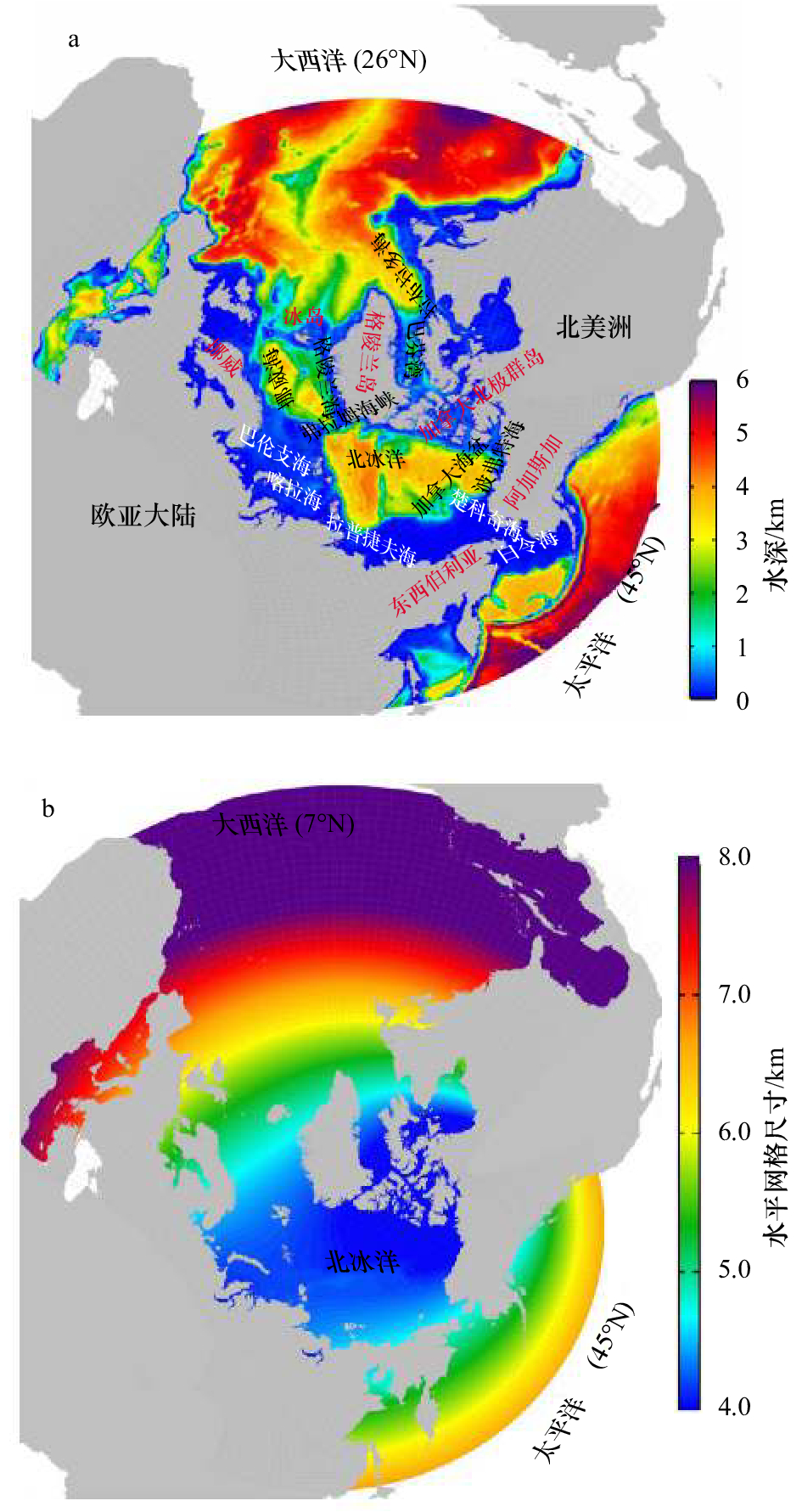
 下载:
下载:
